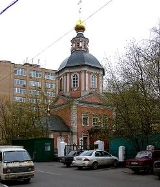
Church of the Savior on Bolvany
Encyclopedia
Church of Transfiguration of Savior
in Bolvanovka , also abbreviated to Saviour in Bolvanovka (Спас на Болвановке), is an Orthodox
church in Zamoskvorechye District of Moscow
.
The neighborhood, Bolvanovka (Болвановка), derives its name from Russian bolvan (болван), which could mean either a billet or, in obsolete sense, a non-Orthodox cult image
. There have different Bolvanovka neighborhoods in medieval Moscow, a sign of wide Tatar presence (e.g. near Taganka Square
).
A legend says that the church stands on site of a Tatar bolvan, an artifact
which symbolized submission of Moscow to Golden Horde
. Ivan III of Russia
destroyed this symbol (or broke ambassador symbol - basma (басма), that has the same name) and established an Orhodox church at this place in 1465. His refusal to pay tribute
to the Horde resulted in the Great stand on the Ugra river of 1480. A wooden church had been mentioned in city records since 1465.
The new baroque
building was built in 18th century; completion date is disputed (1722 or later); what is known definitely is that the church was consecrated in 1755. Alternative accounts assert that there was a succession of wooden churches built in 1708 and 1722; extant building that replaced them was built in 1749-1755.
 The church burnt down in the Fire of Moscow (1812)
The church burnt down in the Fire of Moscow (1812)
and was reopened to worshippers in 1815 with subsequent expansion in 1839. It was closed by Bolshevik
s in 1922, partially destroyed, and returned to the worshippers in 1991. A temporary, standalone wooden belltower was added in 1990s.
Transfiguration of Jesus
The Transfiguration of Jesus is an event reported in the New Testament in which Jesus is transfigured and becomes radiant upon a mountain. The Synoptic Gospels describe it, and 2 Peter 1:16-18 refers to it....
in Bolvanovka , also abbreviated to Saviour in Bolvanovka (Спас на Болвановке), is an Orthodox
Russian Orthodox Church
The Russian Orthodox Church or, alternatively, the Moscow Patriarchate The ROC is often said to be the largest of the Eastern Orthodox churches in the world; including all the autocephalous churches under its umbrella, its adherents number over 150 million worldwide—about half of the 300 million...
church in Zamoskvorechye District of Moscow
Moscow
Moscow is the capital, the most populous city, and the most populous federal subject of Russia. The city is a major political, economic, cultural, scientific, religious, financial, educational, and transportation centre of Russia and the continent...
.
The neighborhood, Bolvanovka (Болвановка), derives its name from Russian bolvan (болван), which could mean either a billet or, in obsolete sense, a non-Orthodox cult image
Cult image
In the practice of religion, a cult image is a human-made object that is venerated for the deity, spirit or daemon that it embodies or represents...
. There have different Bolvanovka neighborhoods in medieval Moscow, a sign of wide Tatar presence (e.g. near Taganka Square
Taganka Square
Taganka Square or Taganskaya Square is a city square at the south-eastern corner of the Garden Ring in central Moscow, formed in 1963 by merging two historic squares, Upper Taganka and Lower Taganka. In 1813 the district of Taganka was reconstructed by Joseph Bové, who built a market there...
).
A legend says that the church stands on site of a Tatar bolvan, an artifact
Cultural artifact
A cultural artifact is a term used in the social sciences, particularly anthropology, ethnology, and sociology for anything created by humans which gives information about the culture of its creator and users...
which symbolized submission of Moscow to Golden Horde
Golden Horde
The Golden Horde was a Mongol and later Turkicized khanate that formed the north-western sector of the Mongol Empire...
. Ivan III of Russia
Ivan III of Russia
Ivan III Vasilyevich , also known as Ivan the Great, was a Grand Prince of Moscow and "Grand Prince of all Rus"...
destroyed this symbol (or broke ambassador symbol - basma (басма), that has the same name) and established an Orhodox church at this place in 1465. His refusal to pay tribute
Tribute
A tribute is wealth, often in kind, that one party gives to another as a sign of respect or, as was often the case in historical contexts, of submission or allegiance. Various ancient states, which could be called suzerains, exacted tribute from areas they had conquered or threatened to conquer...
to the Horde resulted in the Great stand on the Ugra river of 1480. A wooden church had been mentioned in city records since 1465.
The new baroque
Baroque
The Baroque is a period and the style that used exaggerated motion and clear, easily interpreted detail to produce drama, tension, exuberance, and grandeur in sculpture, painting, literature, dance, and music...
building was built in 18th century; completion date is disputed (1722 or later); what is known definitely is that the church was consecrated in 1755. Alternative accounts assert that there was a succession of wooden churches built in 1708 and 1722; extant building that replaced them was built in 1749-1755.

Fire of Moscow (1812)
The 1812 Fire of Moscow broke out on September 14, 1812 in Moscow on the day when Russian troops and most residents abandoned the city and Napoleon's vanguard troops entered the city following the Battle of Borodino...
and was reopened to worshippers in 1815 with subsequent expansion in 1839. It was closed by Bolshevik
Bolshevik
The Bolsheviks, originally also Bolshevists , derived from bol'shinstvo, "majority") were a faction of the Marxist Russian Social Democratic Labour Party which split apart from the Menshevik faction at the Second Party Congress in 1903....
s in 1922, partially destroyed, and returned to the worshippers in 1991. A temporary, standalone wooden belltower was added in 1990s.

